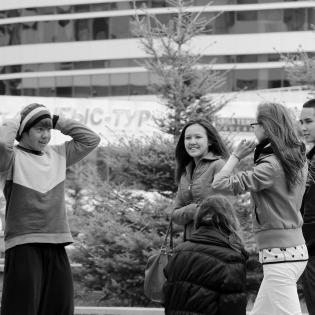Seeing the Other Side
This lesson explores opposing perspectives on fairness issues and whether fairness is based on fact or context. Students compare and contrast different perspectives on two fairness issues - one global and one personal. They reflect on when fairness is a matter to advocate for through citizen action.
The learner will:
- observe when what is unfair to one group or person may benefit another.
- identify the difference between feeling something is unfair and knowing something is unfair.
Instructions
Anticipatory Set
Read aloud a series of statements and listen for immediate emotional responses - just take three or four minutes overall.
- Tomorrow there is an essay due that is worth one-fourth of your grade. Boys write ten pages, and girls write one page.
- People wearing running shoes today get in line first.
- If you have curly hair, you get a seat for the performance.
- You are allowed to use your phone only if your last name begins with S.
- Girls and women in Afghanistan are not permitted to get an education.
- The U.S. schools with families with the fewest resources also have the fewest learning resources.
- Many children in our own state go to sleep hungry, and some do not have a bed to sleep in.
- In the US in 1776, only white men with property had the right to vote. In 1870, the 15th Amendment granted men of color the right to vote, but many were still kept from voting. In 1920, the 19th Amendment guaranteed women the right to vote. There are still conditions that limit voting access for some people.
- There are an estimated 27 million slaves in the world today, many of them are children who are in forced labor, and we may be using some of the products they make.
Discuss what all of these statements have in common (they describe unfair practices). Ask whether all the statements are clearly unfair from anyone's perspective. Then ask why - if the scenarios are clearly unfair - do some of them exist in our world today. Help the learners recognize that unfair practices must benefit someone.
Ask the learners to write (in a journal) a list of things they believe are not fair today. This "Not Fair" list may include ideas from personal issues to world issues. They do not have to share this list.
Tell the learners you want them to choose one of these issues to analyze from a different point of view. For example, if they feel it isn't fair that they have a 9:00 bedtime, they compare and contrast the perspectives of their parents and themselves. Or if they think women are treated unfairly in Afghanistan, they can list the reasons that isn't fair and the existing barriers that prevent equal rights. In their journals, they make a chart that shows both sides of their selected issue(s). Encourage them to reflect on one personal issue and one global issue (if possible in the given time).
Lead them to recognize that even on an issue that seems so clearly unfair, there is an opposite point of view that prevents the easy resolution of the issue. Discuss the difference between feeling something is unfair and knowing something is unfair.
Ask whether there is anything they can do when they think something is unfair. Discuss actions they can take when they KNOW something is unfair.
Philanthropy Framework
-
Strand PHIL.I Definitions of Philanthropy
-
Standard DP 01. Define Philanthropy
-
Benchmark MS.4 Give examples of how individuals have helped others.
-
-
Standard DP 02. Roles of Government, Business, and Philanthropy
-
Benchmark MS.2 Give examples of needs not met by the government, business, or family sectors.
-
-
-
Strand PHIL.II Philanthropy and Civil Society
-
Standard PCS 02. Diverse Cultures
-
Benchmark MS.2 Describe the importance of hearing all voices in a community and respecting their right to be heard.
-
Benchmark MS.5 Discuss examples of groups denied their rights in history.
-
-
